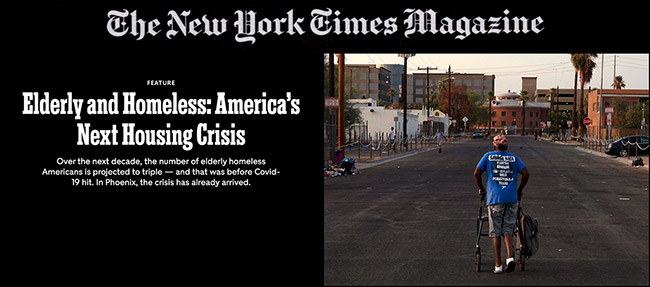Improving Care for Older Adults
News
New York Times Magazine Spotlights Dennis Culhane’s Homelessness Research
Over Next Decade the Number of Homeless Elders Will Triple as Their Health Needs Skyrocket

A lengthy article in the October 4 edition of The New York Times Magazine is structured around the research findings of LDI Senior Fellow and University of Pennsylvania social science researcher Dennis Culhane, PhD.
The Times article is based in part on data from the Culhane-led 2019 study and report, “The Emerging Crisis of Aged Homelessness,” showing that, over the next decade, the population of homeless elderly people will nearly triple and will lack support of a safety net of social services. That study’s findings were published just before the COVID-19 pandemic hit, further stretching safety net social services to their limit.

An emotionally moving piece, the Times Magazine narrative by reporter Fernanda Santos intertwines the life stories of several now-homeless elders in Phoenix with data about how they are typical of millions of people born in the second half of the baby boom from 1955 to 1964, who came of age after the post-WWII boom of prosperity had faded.
The subjects include an elderly Army veteran who worked construction all his adult life, was evicted from his apartment, and was living in his car; a former hospitality industry worker who got a pacemaker, was unable to work, couldn’t get unemployment, and now sleeps in bus stops; and an elderly former Los Angeles lawyer living in a Phoenix tent city because he didn’t want former colleagues to know of his plight.
Hand to mouth existence
A large part of this generation and their families remained in the lower-middle economic strata during their lives, getting by on jobs with few benefits, and salaries low enough to force decades of decisions about whether to make the monthly car payment or eat less that week.
During their adult lives, the members of this demographic “silver tsunami” also saw a nearly-constant diminution of federal and state government safety net programs, along with the skyrocketing health care costs that have left them both more likely to have co-morbidities and often little or no access to required health care as they age into frailty.
Rapidly growing catastrophe
Like Culhane’s research, the Times article looks forward at how the combination of lack of money, housing, and safety net supports is creating a rapidly growing human catastrophe as more elderly individuals move into tattered tent encampments, alleyways and refrigerator boxes every day.
“If we’re forecasting a flood, where the water will reach up to our heads,” Culhane told the Times reporter, “it’s already up to our knees, and rising very, very fast.”